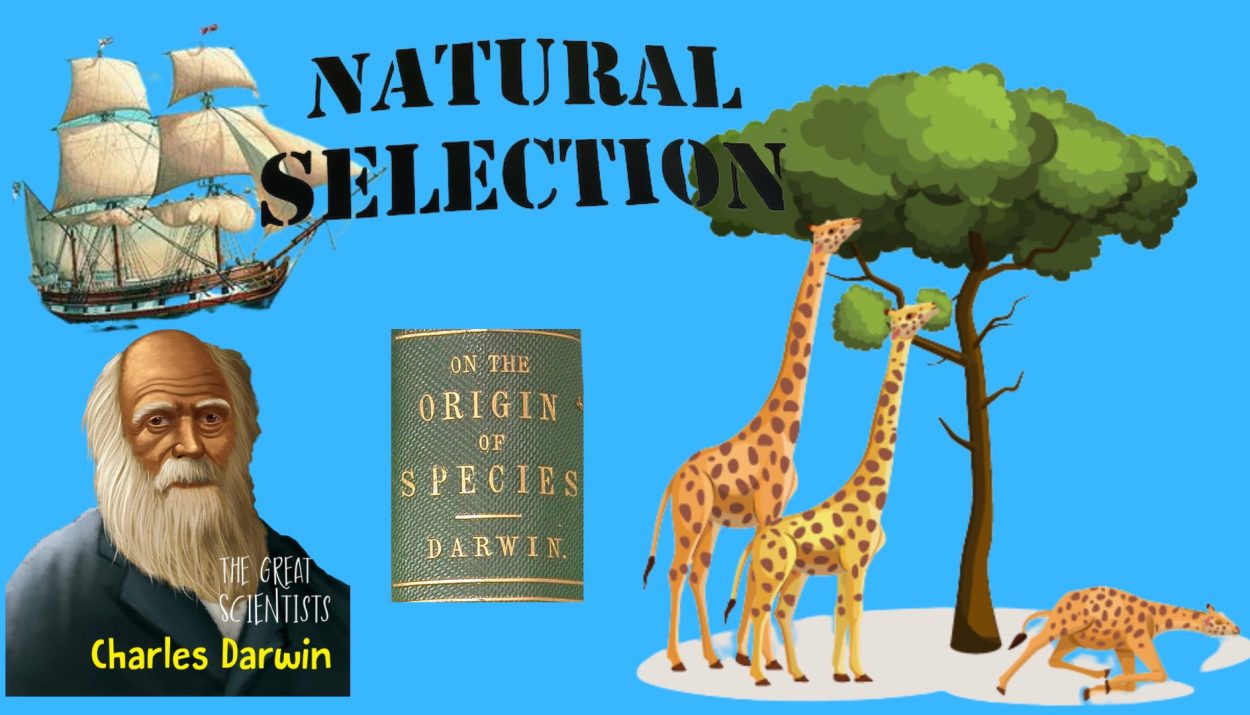The natural selection theory of evolution is given by naturalist, Charles Darwin in 1859 in his book ‘The Origin of Species’. According to him, it is the most important mechanism by which evolution takes place.
Evolution is the process of continuous change within a species as a result of chance occurrences. Natural selection is one of several key concepts underlying the theory of evolution. New species are formed through natural selection, some species change and some are lost due to extinction. The process of natural selection usually takes a long time.
Origin of Natural selection theory
In 1831, Darwin went on a voyage with the British Navy around the world on the ship, HMS Beagle, for 5 years. He observed and collected a wide range of plants and animals. When he returned to England he analyzed his collection.
When Darwin was on the Galapagos Islands off the coast of Ecuador in the Pacific Ocean, he found 15 different species of finches and observed that all birds were similar except for the different shapes of beaks. He concluded that the beaks are different because their diet is different. This suggests that birds must have adapted to their environment over time. This gave rise to the concept of what he called survival of the fittest.
He believed that individual members of a species differ little from each other and that those best adapted to their habitats stand a chance of surviving to reproduce once their beneficial traits become more common, allowing that particular species to flourish. Over long periods, the characteristics of the surviving members of the species will become dominant. For example the length of a giraffe’s neck.
Another example is the peppered moth. In the early 1800s, 98% of peppered moths were light-coloured and only 2% had dark bodies. The light-coloured moths were easily hidden from the birds as they were similar in colour to the trees. Then smoke came out due to Industrial Revolution and the trees turned black with soot. This allowed the dark-coloured moths to survive better in their environment. By 1895, dark-coloured moths accounted for 95% of the population.
There is a struggle for existence. The fittest survive. This whole process is called natural selection.
Concept of natural selection
Natural selection is defined as the mechanism by which environmental forces decide the survival of a species. All individuals in a population are different. This means that some individuals have better qualities than others.
All living beings go under variations. Not all variations are suited to the environment. Only those variations survive and thrive which are suitable for the environment. Variation is the tendency of an organism to deviate from the parental generation. Variation occurs with all organisms, in part due to mutation, and is hereditary. Some changes are favourable and some are unfavourable. Favourable survived and unfavourable perished.
Individuals have to struggle for existence. Those who fit better are selected by nature. This mechanism is called survival of the fittest. The continuation of a family of one species and the extinction of another is the result of natural selection.
Types of struggle
Intra-specific struggle– Here members of the same species compete for limited resources. For example, two male birds of the same species compete for mates in the same area.
Inter-specific struggle– means competition between individuals of different species. For example, predators of different species compete for the same prey.
Environmental struggle– means you are against the environment. Like a flood, drought, heat, cold, earthquakes, etc.
Natural selection led to speciation meaning one species give rise to new distinct different species. This process of speciation is one of the evolutionary processes.
Criticism of Darwin’s theory
Darwin’s theory of natural selection is widely accepted by most biologists and scholars. But there are several objections as follows-
- Darwin was unable to explain the mechanism of inheritance of the characters. He didn’t know about the genes. He had no scientific backup for the inheritance of traits.
- He failed to explain the reason behind variations. He was unable to distinguish between heritable and non-heritable variations. He focused on favourable and unfavourable variations.
- According to Darwin, only useful characters are passed on. Then why do the vestigial organs exist? (vestigial organs are no longer as functional as they were in their ancestors. Examples- Appendix, wisdom teeth, coccyx).
- He explained that evolution is gradual and slow but it is not true in all cases. Some fossils are found which showed the sudden appearance of wild new animals.
- He did not explain the extinction of organisms which had many specialized organs. For example- the extinction of a mammoth.
Conclusion
Today it is widely accepted as our best scientific explanation of how life on Earth works. A species that has a better ability to adapt survive, while other species that fail to adapt to variations are eliminated by the environment. As a result, the better-adapted species increase in number and gradually replace the less-adapted species.
If the environment changes rapidly it becomes impossible for the species to adapt and survive through natural selection. For example the extinction of the dinosaurs. An invasive species (a non-native species from another area) also cause the extinction of native species.
Today, human activities such as hunting, over-harvesting, pollution and other environmental destruction are the main causes of extinction. The rate of extinction is much faster today than in the past.
References
Darwinism Theory of Evolution (With Criticism) | Biology
